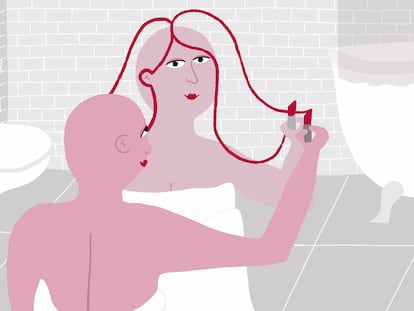‘In the future, being bald will be a choice’: A procedure and two pills change the fight against alopecia
While the hair transplant market moves $9.5 billion a year, complementary treatments are boosting an emerging industry
There are things you just can’t hide from your barber. Miguel Jiménez Guillamón can attest to this: when he opened his barbershop in 2005, no one spoke about transplants. Little by little, however, he began to see thick heads of hair where there used to be minimal coverage; generous bangs over formerly exposed foreheads. “I also saw specific scars that I began to identify,” he explains. They were hair transplants. Jiménez took notice. He was barely 20 years old, but he had already started to lose his hair. “That affected me,” he says. “I was less confident with the girls or on the street. Also, at work, I spent the day in front of the mirror.”
In 2012, he decided to start a YouTube channel to share advice on hair care, but he was embarrassed to upload content. “I thought, ‘Who’s going to want to see a bald barber?’” As it turns out, a lot of people. Michael — his social media name — spoke openly about his experience with hair loss and gained 300,000 followers. Then he spoke about his first transplant in Spain. The year was 2014, and things were about to change. By the time he underwent a second surgery (in Turkey, in 2017) a million people were watching his videos. That is how he realized that he was not alone. Nobody talked about it openly, but everyone was looking him up. “It’s normal. You don’t realize how important your hair is until you lose it,” he reflected.
By the time they are 30, one in four men has begun to lose his hair. At 50, nearly half find themselves in this situation, which 10 years later affects two out of three. It is the most evident effect of androgenic alopecia, which causes 95% of baldness cases in men. The other, least visible consequences, are psychological: low self-esteem, anxiety, and depression. Psychologist Dirk Kranz, who is bald and the author of the aptly named study Bald and Bad?, points out that these concerns are not unfounded. “Being bald brings social disadvantages when applying for a job or dating a person. Men with a full head of hair are perceived more positively, as numerous studies have shown,” states Kranz.
“In some cultures, such as in East Asia (and formerly in the European context), hair loss in men is also associated with positive attributes such as morality, intelligence and wisdom,” explains the expert. However, the Western ideal of beauty is becoming globalized, and a full head of hair seems essential to fit into it. Just take a look at the powerful industry that has grown around hair; or rather, around its absence.
According to the Medihair platform, approximately 3.4 million hair transplants were performed worldwide in 2021. The world market for this procedure was then valued at around $9.5 billion; more than double the GDP of a small country like Andorra, and triple the amount that was invested that same year to eradicate malaria in the world.
Synthetic hair, the next frontier
A transplant does not make new hair grow; it merely changes its location. This means that some patients with very advanced degrees of alopecia cannot get one. In those cases, new hair would need to be created. That is the last frontier, and it is close to being conquered. Stem cell biologist Karl Koehler of Harvard University has been using stem cells for a decade, and he has created patches of human skin that grow hair follicles over time. This opens the door to a future with synthetic hair.
Maksim Plikus, a biologist from the University of California, is experimenting with Scube3, a protein that promotes hair growth. His idea is to inject a messenger RNA vaccine to order the body to release this enzyme. In a recent article published in New Scientist magazine, Plikus stated that his team is about to reach a turning point. Optimism in this field is not dependent on a single treatment, which increases the chances of finding an effective strategy. But before understanding what the future holds, we must look back.
In recent years, science has deciphered the hair loss process, finding some products that can significantly delay it. The origin of this story is difficult to pinpoint: the case of a prison in Oklahoma, where the inmates who were serving sentences for rape and had been castrated recovered their hair, is frequently mentioned; other bibliographical references place it in the Dominican Republic, where a series of families in a town with many intersex children were studied. The fact is that science, at some point in the 20th century, began to relate testosterone, a male hormone produced in the testicles, with hair loss.
Over the following decades, researchers learned that it did not act alone. “An enzyme turns it into a substance called dihydrotestosterone, or DHT, which causes hair follicles to shrink,” explains Mario Puerta Peña, a dermatologist specializing in trichology at the Doctor Morales Raya Clinic in Madrid, Spain. Follicles are like hair factories, and DHT attacks the engine of the factory, the dermal papilla. “It atrophies, and the hair it produces is increasingly finer and shorter. It becomes miniaturized,” explains Puerta. It can remain suspended in this state for a few months; then it disappears. Thus, bald people still have the same hair factories as the rest of the people, but they are shrunken. It could be said that there are no bald people, but rather people with small follicles.
This understanding has resulted in the discovery of an effective treatment to fight and delay hair loss. There are two pills that keep many men away from the transplant (and many others happy with it). Without them, the graft would be a temporary patch — hair today, baldness tomorrow.
The science of baldness and testosterone
“They are oral antiandrogens,” explains Puerta. “Finasteride and dutasteride, which inhibit the transformation of testosterone to dihydrotestosterone.” Eliminating the hormone that attacks the follicles delays, and even reverses, miniaturization. For the most extreme cases there are also subcutaneous injections. These also serve to localize the treatment in a specific area and avoid possible side effects. Some patients have reported less sexual desire; an extreme that is still being disputed and not completely proven.
Dutasteride was used to treat prostate cancer, but the visible effect it had on hair led to a new use being studied and patented. Something similar is happening with minoxidil, a drug that was originally developed to improve blood pressure; it was found to increase blood flow to the head area, which in turn improves the vigor of the hair. “In recent years, it has been discovered that its oral formula works better than the topical formula, and is less cumbersome,” says Puerta. “But no pharmaceutical company sells it.” Some users choose to go on a drugstore pilgrimage in search of Loniten, an almost discontinued formulation of minoxidil designed for blood pressure that does not cost much. However, facing the shortage, many users are forced to purchase the more expensive master formulation. The combined treatment, dutasteride and minoxidil, can cost more than $60 a month; thus, having hair is starting to become a matter of purchasing power.
Pel de Ric (“rich man’s hair” in Catalan) knows it well. With this ironic name, an Instagram account publishes photos of the lustrous manes of wealthy men. “There is a class component in hair,” confirms JLH, one of the four authors of this account, who prefers to remain anonymous. “We started all this as a joke; we simply gave a name to a type of person, a character, and added clever copies. And it worked in some way — it’s a joke that 80,000 people have understood.” Pel de Ric focuses on gray-haired gentlemen, ostensibly older than JHL, who recognizes that there is also a generational factor. “There are more and more treatments, pills, grafts, etcetera. When they were our age, they didn’t have the resources that we have,” he reflects.
Puerta confirms this idea. “Very young people come, whose hair is more or less okay, or with a very slight degree of alopecia. There are even parents who come with their children, 17, 18 years old, who are aware that it is hereditary and want to spare them that fate,” he explains. The standards of masculinity are changing, and treatments and grafts are no longer taboo. Before, friends used to hide; now they go to the clinic as a group. Between the treatments, which begin at increasingly younger ages, and the transplants, which can help in the most extreme cases, experts believe that androgenic alopecia can be reduced to an increasingly residual phenomenon. “In the future, being bald will be a choice,” says Puerta.
Sign up for our weekly newsletter to get more English-language news coverage from EL PAÍS USA Edition
Tu suscripción se está usando en otro dispositivo
¿Quieres añadir otro usuario a tu suscripción?
Si continúas leyendo en este dispositivo, no se podrá leer en el otro.
FlechaTu suscripción se está usando en otro dispositivo y solo puedes acceder a EL PAÍS desde un dispositivo a la vez.
Si quieres compartir tu cuenta, cambia tu suscripción a la modalidad Premium, así podrás añadir otro usuario. Cada uno accederá con su propia cuenta de email, lo que os permitirá personalizar vuestra experiencia en EL PAÍS.
¿Tienes una suscripción de empresa? Accede aquí para contratar más cuentas.
En el caso de no saber quién está usando tu cuenta, te recomendamos cambiar tu contraseña aquí.
Si decides continuar compartiendo tu cuenta, este mensaje se mostrará en tu dispositivo y en el de la otra persona que está usando tu cuenta de forma indefinida, afectando a tu experiencia de lectura. Puedes consultar aquí los términos y condiciones de la suscripción digital.
More information

We need to talk about alopecia–and Jada Pinkett would agree
Archived In
Últimas noticias
Maduro pleads not guilty before the federal court in New York: ‘I am still the president of Venezuela’
A new test can detect Alzheimer’s from a finger prick
UN team enters Sudanese city of El Fasher after paramilitary massacre: ‘It’s like a ghost town’
A recipe for resistance: Indigenous peoples politicize their struggles from the kitchen
Most viewed
- Gilles Lipovetsky: ‘If you want to live better and fall in love, take Prozac, don’t look to philosophy’
- Alain Aspect, Nobel laureate in physics: ‘Einstein was so smart that he would have had to recognize quantum entanglement’
- Alvin Hellerstein, a 92-year-old judge appointed by Bill Clinton, to preside over Maduro’s trial in New York
- Why oil has been at the center of Venezuela-US conflicts for decades
- Maduro’s downfall puts China’s relationship with Venezuela to the test









































